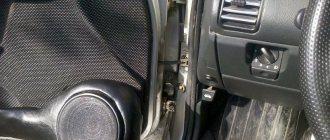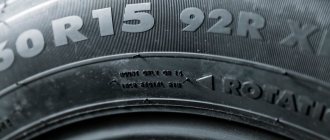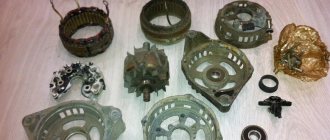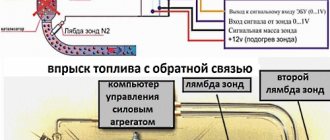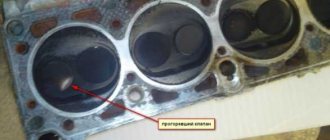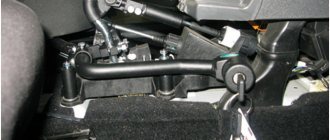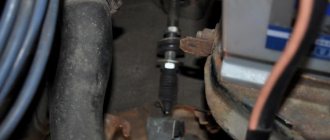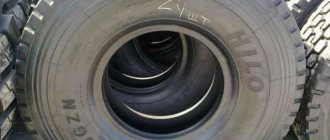A side cut of a tire is an order of magnitude more serious problem than a situation with a regular puncture. However, it happens that urgent repair of a cut on the side surface of a tire is simply necessary and there is no alternative. At the same time, it is important not to forget that such a defect requires a high-quality and professional approach, and even in this case the risk of complete destruction of the tire will be quite high. In addition, it is not always possible to eliminate a side cut, even theoretically - it all depends on the type of tire and the extent of the damage.
Acceptable cut sizes
If the sidewall of a car tire is cut, the cord is damaged, the threads of which form an internal frame that provides the rigidity, shape and strength of the tire. This means that the tire instantly loses its properties, and therefore only minor damage can be repaired. Otherwise, the efforts made lose all meaning - it is impossible to repair the tire, and it is impossible to guarantee driving safety.
Let us recall that in radial tires the cord threads are located perpendicular to the circumference of the wheel, and in diagonal tires - at a certain angle and overlapping. At the same time, repairing a sidewall cut is more effective in radial models. One consolation is the fact that bias-ply tires are practically never found today.
The degree of damage to the side surface is determined by its critical dimensions:
- A longitudinal cut that runs along the cord threads, and which you can try to eliminate, should not exceed 50 millimeters.
- A transverse cut whose size is more than 30 millimeters is no longer repairable.
Moreover, if the end of the tear is located closer to the edge of the tire than four centimeters, then such rubber can no longer be used. Regardless of its type, degree of wear or quality of rubber.
Truck tires stand apart, the repair of which causes more difficulties. Due to increased loads and operating characteristics, a cut that touches ten cord threads is considered critical here. If more than a dozen fibers are destroyed, then the tire can only be thrown away.
Tire repair - side cut and its permissible dimensions
Typically, when a cut occurs, the inner frame of the tire, called the cord, breaks. If the damage is minor, it is possible to eliminate this defect, however, if the damage is serious, then any repair loses all meaning. The side cuts of tires are determined by critical dimensions. For a longitudinal cut that runs along the cord, this value is 35 millimeters, and for a transverse cut this figure is even smaller and is only 25 millimeters. If the tear ends closer than 40 millimeters from the edge of the tire, it is no longer subject to any repair.
Certain difficulties arise when it is necessary to repair the side cuts of truck tires. In this case, the patch needs to be fixed more carefully, and the loads that it will have to withstand in the future will cause mandatory periodic checks of the integrity of the patch. For a truck tire, the cut limit is 10 cord fibers; if the damage affects more cables, then repair is useless.
Damage repair and further operation
Repairing a sidewall cut is fundamentally different from repairing a tire with regular tread punctures. This is due to the smaller thickness of the side surface of the tires. In addition, this part of the wheel experiences more significant deformations and loads when traffic moves. Especially on roads with poor surfaces.
Do-it-yourself tire side cut repair
The most effective way to eliminate the damage to a car tire in question consists of a number of operations.
- The cut is given the shape of a bowl, for which its edges are ground off with a fine abrasive. This is necessary to securely glue the reinforcing patch.
- Next, the treated cavity is degreased with solvent, gasoline or alcohol, and evenly filled with raw rubber.
- The tire prepared in this way is sent for vulcanization. The procedure is performed using a production hairdryer or a special camera.
- The final stage involves cleaning the patch installation site and gluing it, followed by static balancing of the wheel.
Obviously, a side cut, the parameters of which are not critical, is quite possible at home. However, the use of a tire retreaded in this way should be treated with care, since even after careful repairs carried out on your own, wheel runout may occur. If it is not possible to replace a tire, then it is better to use it as a “spare tire”.
This technique is not suitable for all side cuts. Often, a tire with such damage should not be repaired at all, but only replaced with a new one. With cuts of significant size, there is always a risk of the reinforcing patch tearing off while driving at high speed, which can lead to dire consequences. For this reason, repairs on your own should be approached as painstakingly, carefully and seriously as possible.
Reasons for refusal to repair side tire cuts
Repair for a tire side cut will most likely be denied if:
- it is located at the base of the tire bead;
- the size of the side cut exceeds the boundaries established by the manufacturer, which are thirty-five millimeters for a longitudinal cut and twenty-five for a transverse cut;
- it crosses the area of the shoulder girdle of the tire, which is maximally loaded;
- The tire is tubeless.
Truck tires have different requirements because they are subject to increased pressure, which can cause an explosion. It is imperative to evaluate the number of damaged cord fibers, since if the integrity of more than a dozen is broken, then hot vulcanization will not help.
If it is not possible to completely repair the side cut of a tubeless tire, then experts can advise:
- buy new tires;
- subject the side cut of the tire to a hot vulcanization procedure, and then use it as a spare tire;
- repair a tubeless tire by installing a high-quality nipple-type tube;
- pay more money and order the installation of a foreign patch to fix the side cut. At the same time, more than half of truck drivers are categorically against tire repairs.
Cleaning the tire surface with a drill
They advise throwing away the tire and purchasing a new set of tires, which is very unprofitable financially. In the event that the side cut does not go through and the cord threads are not affected, then repairing the tire consists of simply sealing the damage.
Is it possible to seal a side cut on a tire?
Damaged tires are sealed with special cord plasters made of pressed rubber. If the upper punctures can be processed coldly by placing a patch on glue, then repairing the lateral damage is labor-intensive and requires a highly qualified technician. It takes place in several stages:
- the tire is removed,
- the edge is processed so that the hole takes the form of a “funnel”,
- the edge of the cut is lubricated with special cement,
- the “funnel” is filled with thinly sliced raw rubber,
- the edges of the cut are sealed with a vulcanizer,
- the surface around the seam is sanded and degreased,
- a reinforced patch is applied to the seam,
- The tire is returned to the wheel and balancing is carried out.
Sometimes situations arise on the road when you need to repair your car immediately. Repairing a tire side cut with your own hands requires great care and strict adherence to the order of the stages of this process.
Stages of self-repair of tube tires (with an intact tire):
- put the wheel on a jack and carefully examine the nature of the cut,
- if cord threads stick out outside or inside, they must be completely cut off so that they do not damage the camera,
- Inject a special aerosol from a can through the nipple into the tire, turn the wheel several times so that the product is evenly distributed inside and seals the scratch.
How to repair a tire side cut with your own hands (tubeless tires):
- degrease the cut surface with alcohol, wipe dry with a clean cloth,
- use an awl to slightly enlarge the hole and carefully distribute the glue on the inner surface of the cut,
- soak the harness (included in the tire repair kit) with glue and screw it into the hole using an awl,
- wait a little for the glue to “set” and pull out the awl (it should come out without effort),
- inflate the wheel, check for leaks,
- cut off the protruding ends of the harness.
You should continue driving very carefully, gradually increasing the speed and load on the wheels. It is recommended to have your tires diagnosed at a professional workshop as soon as possible.
There is no clear answer to the question of whether it is advisable to repair side cuts or whether it is better to buy a new tire. It all depends on the specific situation, in each case the owner of the car decides. It is possible to repair a torn tire, but at high speeds and rough roads it can burst again and lead to unforeseen consequences. Often, drivers make a compromise - they repair the tire, but use it only as a spare tire for short distances.
Technological process for repairing a side cut:
So. There is a side tire cut in front of you. First of all, the tire is dismantled. Then the edges of the side cut are processed with nippers for better boiling...
Next, the side of the cut is cleaned with a drill and treated with a special compound...
Then the raw rubber is prepared: cut into thin strips and stretched.
The side cut becomes clogged with damp rubber.
And it is brewed in a vulcanizer.
Next, a place is marked for a special cord patch.
The side of the tire is cleaned with a drill. It is treated with a degreaser and spread with special glue. When the glue dries, we begin the cold vulcanization process.
The edges of the patch are treated with sealant.
The tire is mounted on the rim and balanced. The wheel is ready for use.
Bon Voyage!
How to repair a side cut yourself?
Eliminating the problem in question is fundamentally different from repairing rubber with standard tread punctures. This feature is associated with the smaller thickness of the side surface of the tire. In addition, this part of the wheel receives increased impact and dynamic deformations. Overload is especially felt on bad roads and when driving off-road.
To resolve these problems, the optimal method is considered to be the following:
- The side cut is processed in such a way that a bowl configuration is obtained. To do this, use a fine abrasive to grind down the edges of the deformed area. This stage is very important, since it subsequently ensures reliable gluing of the reinforcing patch.
- Then the treated part is degreased with white spirit, alcohol or other substances, after which it is filled with an even layer of raw rubber.
- The prepared tire is sent for vulcanization. The manipulation is performed using an industrial hair dryer or a special camera.
- At the final stage, the patch installation site is cleaned, then static wheel balancing is done.
Tire side cut: repair or replacement?
After repairing a tire, it needs special attention. Several points should be highlighted:
- if the tires on the front axle burst, the vehicle’s controllability drops sharply, which can lead to it going into a ditch;
- if this happens on the rear tire, the risk of a serious accident is several times lower;
- You should not mount the restored wheels at the front, since the large mass of the body puts an increased load on the front tires, especially on cars with a driven front axle.
In any case, you should not get carried away with high speeds on tires with a repaired side cut, since even the most modern technologies do not restore its properties 100%.
